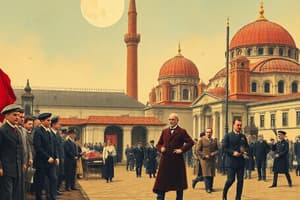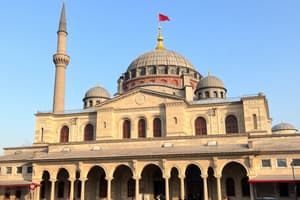Podcast
Questions and Answers
Who was Osman?
Who was Osman?
The leader of a new group of Turks that began to build power in the northwest corner of the Anatolian Peninsula in the late thirteenth century.
What were janissaries?
What were janissaries?
An elite military guard recruited from the local Christian population who were converted to Islam and served the Ottoman Empire.
What new technology helped the Ottoman troops expand into the Balkans?
What new technology helped the Ottoman troops expand into the Balkans?
Firearms.
Where in the Byzantine Empire did Mehmed II, the Ottoman sultan, begin an attack in April 1453?
Where in the Byzantine Empire did Mehmed II, the Ottoman sultan, begin an attack in April 1453?
When did Süleyman's push into Central Europe end, and why?
When did Süleyman's push into Central Europe end, and why?
How did pashas and the grand vizier help the sultan rule?
How did pashas and the grand vizier help the sultan rule?
What is the link between the sultans and the ulema?
What is the link between the sultans and the ulema?
How did the Ottomans treat non-Muslims?
How did the Ottomans treat non-Muslims?
What were the five main occupational groups in the Ottoman Empire?
What were the five main occupational groups in the Ottoman Empire?
Who was Sinan, and why was he important?
Who was Sinan, and why was he important?
How did the Ottomans build and expand a strong empire?
How did the Ottomans build and expand a strong empire?
What kind of ruler was Süleyman I?
What kind of ruler was Süleyman I?
What was the result of Süleyman I preserving the throne for his son Selim II?
What was the result of Süleyman I preserving the throne for his son Selim II?
How did government change after the death of Süleyman I?
How did government change after the death of Süleyman I?
What economic pressures did the empire face?
What economic pressures did the empire face?
What changes occurred as a result of the influence of Western ideas?
What changes occurred as a result of the influence of Western ideas?
When did the Safavid Empire arise, and what unified it?
When did the Safavid Empire arise, and what unified it?
How did Shāh 'Abbās bring the Safavid Empire to the height of its power?
How did Shāh 'Abbās bring the Safavid Empire to the height of its power?
What is religious orthodoxy, and how did it influence daily life?
What is religious orthodoxy, and how did it influence daily life?
Flashcards are hidden until you start studying
Study Notes
Ottoman Empire Overview
- Osman led a new group of Turks in the late thirteenth century, establishing the foundation of the Ottoman Empire in the northwest Anatolian Peninsula.
- Janissaries, an elite military unit, were recruited from the Christian population, converted to Islam, and played a key role in the empire's military.
- Mastery of firearms significantly aided Ottoman expansion into the Balkans.
Key Historical Events
- In April 1453, Mehmed II launched an attack on Constantinople, marking a crucial point in history that led Europeans to seek new trade routes.
- Süleyman's advances into Central Europe halted with the failed siege of Vienna in 1529, leading to internal family conflicts due to hereditary succession.
Administrative Structure
- Pashas, as local rulers, were responsible for tax collection and maintaining law and order, while the grand vizier led the imperial council and communicated policies to the sultan.
- Sultans delegated religious responsibilities to the ulema, who managed the legal system and educational institutions for Muslims.
Social and Cultural Aspects
- The Ottomans allowed non-Muslims to practice their religions but imposed a tax on them.
- Society was divided into five occupational groups: ruling class, merchants, artisans, peasants, and pastoral peoples.
- Sinan, the greatest Ottoman architect, constructed 81 mosques featuring domes and minarets during the mid-sixteenth century.
Empire Strength and Decline
- Expansion of the Ottoman Empire was fueled by advanced military tactics, a centralized government, and cultural tolerance.
- Women held a relatively better position in Ottoman society compared to other Muslim societies.
- The reign of Selim II, known as "the drunken sultan," marked the beginning of the Ottoman Empire's slow decline.
Government and Economy
- Post-Süleyman I, the government saw diminished sultan involvement, leading to increased corruption and the rise of privileged groups.
- The empire faced economic challenges from ongoing wars, inflation, a trade imbalance with Europe, and price regulations affecting guilds.
- Western influences led officials and merchants to adopt European customs, including style and consumption of goods like coffee and tobacco.
Safavid Empire Context
- The Safavid Empire emerged in the early 1500s and was unified by the Shia faith, founded by Shah Esmail.
- Shah 'Abbās enhanced the Safavid Empire's power by appointing efficient administrators, establishing a permanent army armed with modern weaponry, and relocating the capital for strategic advantage.
Religious and Cultural Influence
- Religious orthodoxy emphasized conformity to traditional beliefs, affecting daily life with practices like the seclusion of Persian women and the requirement to wear veils.
- Bazaars functioned as essential commercial centers, providing access to diverse goods and fostering trade within society.
Studying That Suits You
Use AI to generate personalized quizzes and flashcards to suit your learning preferences.




